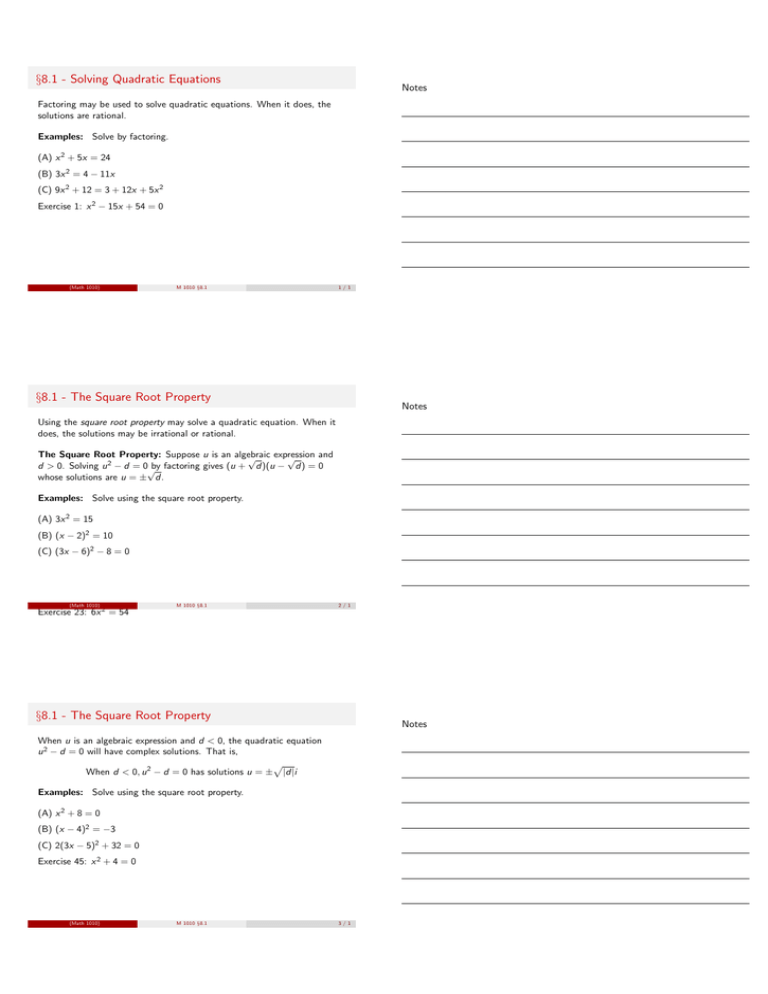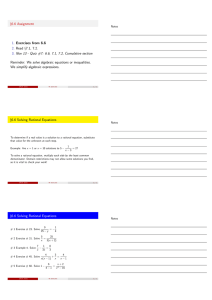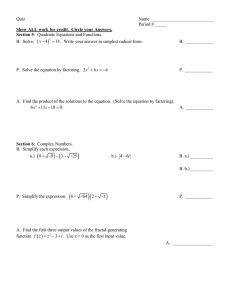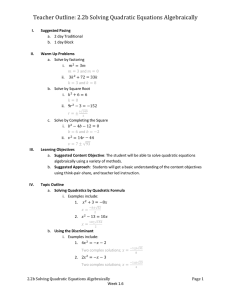§8.1 - Solving Quadratic Equations Notes
advertisement

§8.1 - Solving Quadratic Equations Notes Factoring may be used to solve quadratic equations. When it does, the solutions are rational. Examples: Solve by factoring. (A) x 2 + 5x = 24 (B) 3x 2 = 4 − 11x (C) 9x 2 + 12 = 3 + 12x + 5x 2 Exercise 1: x 2 − 15x + 54 = 0 (Math 1010) M 1010 §8.1 1/1 §8.1 - The Square Root Property Notes Using the square root property may solve a quadratic equation. When it does, the solutions may be irrational or rational. The Square Root Property: Suppose u is an algebraic expression and √ √ d > 0. Solving u 2 − d = 0√by factoring gives (u + d)(u − d) = 0 whose solutions are u = ± d. Examples: Solve using the square root property. (A) 3x 2 = 15 (B) (x − 2)2 = 10 (C) (3x − 6)2 − 8 = 0 (Math 1010) Exercise 23: 6x 2 = 54 M 1010 §8.1 2/1 §8.1 - The Square Root Property Notes When u is an algebraic expression and d < 0, the quadratic equation u 2 − d = 0 will have complex solutions. That is, p When d < 0, u 2 − d = 0 has solutions u = ± |d|i Examples: Solve using the square root property. (A) x 2 + 8 = 0 (B) (x − 4)2 = −3 (C) 2(3x − 5)2 + 32 = 0 Exercise 45: x 2 + 4 = 0 (Math 1010) M 1010 §8.1 3/1 §8.1 - Special Quadratic Forms Notes The special form to discuss last is an equation in ”quadratic form.” Suppose u is an algebraic expression. Then we can use our techniques to solve in terms of u: au 2 + bu + c = 0 Examples: Identify the algebraic expression u. (A) x 4 − 13x 2 + 36 = 0 (B) x 4 − 5x 2 + 4 = 0 √ (C) x − 5 x + 6 = 0 (Math 1010) M 1010 §8.1 4/1 §8.1 - Special Quadratic Forms Notes The special form to discuss last is an equation in ”quadratic form.” Suppose u is an algebraic expression. Then we can use our techniques to solve in terms of u: au 2 + bu + c = 0 Next we solve the quadratic equation in terms of u, then solve u in terms of x. Examples: Write each in terms of u, solve for u, then solve for x. (A) x 4 − 13x 2 + 36 = 0 (B) x 4 − 5x 2 + 4 = 0 √ (C) x − 5 x + 6 = 0 (Math 1010) M 1010 §8.1 5/1 Notes








